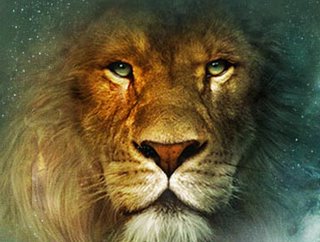Jesus and Liam Neeson’s Lion

C.S. Lewis was a devout Christian . His children’s books about Narnia are allegories about the Christ story — that much is clear. Never having read those books myself, I was prepared to explore his theology through the film when I went around the corner tonight to watch it in the local movie house.
Frankly, I didn’t quite get it. The trouble with the New Testament — and probably for almost all other holy books — is that you can pick out the message you prefer, while someone else will pick out antithetically different doctrines. I am religious, but whether I am authentically Christian can be contested by anyone who reads the Bible differently, including C.S. Lewis. This little essay can be neither film criticism nor theology nor even an analysis of Lewis’s understanding of ultimate reality. It is just my misguided attempt to squeeze more meaning from the film than it actually contains.
One cannot equate the film’s character to any biblical characters on a one-to-one basis. Indeed, I have trouble translating the symbols with any consistency at all – though perhaps the books would be easier than the movie.
Four siblings — two little girls and two boys — go through a wardrobe into a strange snowy country, where they are challenged to save the society from an evil “White Witch,” who rules the frozen land. (Is this an inversion of the dark, male Satan who rules a fiery hell?) There’s a lot of soft-edged violence. In fact, the whole point of the story is that the children (“sons and daughters of Adam and Eve”) must fight a war of liberation, joining forces with her opponent, a lion named Aslan. The witch is plenty powerful, capable of turning her enemies into stone. However, the lion is a good guy. Speaking wisely with the mellifluous voice of Liam Neeson, he is the only character who stands unmistakably for a biblical personality: Jesus himself.
Toward the end of the film the parallels between it and some biblical plots become transparent, if theologically opaque. One of the brothers betrays his siblings and endangers them all by his susceptibility to the White Witch’s influence. They rescue him and Aslan instructs them not to hold his misdeeds against him. (Okay, he must represent Judas, but did Christ instruct his disciples not to hold a grudge against his betrayer?) Evidently the child learns his lesson, for he displays more integrity thereafter.
Next the White Witch comes to kill the Judas boy, quoting deep founding principles that prove her claim is legitimate. (Well, fair enough. The Bible does say that someone has to suffer for humanity’s flaws, which is why Christ sacrificed himself. However, I’ve never admired a god who would demand such a deal.) Anyway, Neeson the lion saves the boy by offering his own life instead. He takes a sad stroll through Gethsemane at night, then proceeds to the White Witch’s temple and surrenders, whereupon she slays him on a stone altar. The little girls watch him die, then mourn and start to depart, only to hear a great noise. They find that the temple has collapsed and the lion’s body has disappeared. Then, as the sky glows, Aslan reappears, again alive. It’s Easter, no doubt. He gives the girls a ride on his back as he races to the battle that their brother is leading against the army of the White Witch.
The remaining story is derived more from Hollywood action film tradition than from the Gospels. An overly long battle is waged between Aslan’s army (wearing costumes recycled, I guess, from an old production of Henry V) and the White Witch’s troops (recruits from Shrek and Dungeons and Dragons). That evil woman is about to slay the older of Adam and Eve’s male descendants, who has been commanding the army in Aslan’s absence, when the lion reaches the scene, pounces, and kills the witch while saving the youth. Afterward, he installs the four kids as kings and queens to rule his realm, bids them a Liam Neesonesque farewell, and strolls away, swinging his tail with cosmic satisfaction. It’s less dramatic than the account in Revelations of Christ’s departure in the clouds, but it’s pretty impressive for a lion.
This last part makes no sense as a Christian metaphor, but anyway they had already lost me back there on Golgotha. What is this war all about? Does the White Witch’s army represent Satan’s forces of evil, or are they just supposed to be Roman legionnaires? In the New Testament, there’s no battle. There are some Roman soldiers who crucify Jesus, but his disciples obey his instructions not to resist them. The early Christians were remarkably insistent about being peacemakers. This plot runs completely counter to the central message of Christianity. And even if you're not a Christian, you may dislike it, especially if you read the newspapers.
I can only conclude that C.S. Lewis was (probably unknowingly) a Manichaean. The whole plot of Narnia turns on the concept of a struggle between two eternal principles, good and evil. But that polarity did not characterize either Christian or Jewish theology. Manichaeism did not exist until the latter half of the third century, when a Persian fellow attempted to synthesize all religious doctrines, adding a few minor Christian features to the mixture.
Or is it only Hollywood that is Manichaean? Perhaps so. After all, plots about the struggle between good and evil are a lot more exciting than stories about peace. I don’t particularly want to read the novels, so if some of you readers are familiar with them, please add a comment here and tell me whether C.S. Lewis believed that Christians are in a cosmic battle between good and evil.



0 Comments:
Post a Comment
<< Home